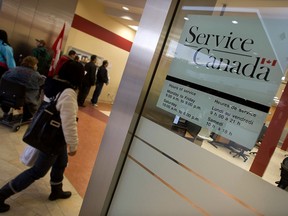Country gained just 100 jobs in December, while economists had expected 15,000

Article content
Canada’s labour market missed expectations for jobs gains, confirming a marked slowing of the economy at the end of last year.
The number of employed people was essentially unchanged in December, while the unemployment rate held steady at 5.8 per cent, Statistics Canada reported Friday in Ottawa. That fell short of forecasts for a gain of 15,000 positions, according to the median estimate in a Bloomberg survey of economists.
Advertisement 2
Article content
Article content
Wage increases for permanent employees accelerated to 5.7 per cent over the prior year, higher than expectations for a 5.4 per cent rise, and up from five per cent a month earlier. That’s the strongest pace since January 2021.
Overall, the report shows an economy in which growth is cooling because of high borrowing costs. That gives policymakers some room to consider lowering interest rates in the coming months. Still, wage growth remains an inflation risk if it persists.
The Canadian dollar briefly fell to the lowest intraday level since Dec. 19 after the release of Canadian and U.S. employment data — the latter was stronger than economists’ forecasts — then recovered. The loonie was trading up at $1.3309 per U.S. dollar at 10:29 a.m. in Ottawa.
Bonds initially slumped after the jobs figures were released, then reversed. The benchmark Canada two-year yield declined more than four basis points to 4.008 per cent.
“Today’s sluggish results suggest that the softening seen in the broader economy is finally catching up with the job market,” Doug Porter, chief economist at Bank of Montreal, said in a report to investors. He expects the jobless rate to push above six per cent in coming months and “eventually take some steam out of wage gains.”
Article content
Advertisement 3
Article content
Labour force growth stalls
Canada has one of the world’s fastest rates of population growth because of high levels of immigration. But employment growth has been slower than the expansion of the labor force in recent months.
The population aged 15 and older grew by 74,000 in December, on par with average monthly population growth in 2023 of 79,000. Yet this time, it didn’t translate into significant growth in the labour force.
The employment rate — the proportion of the working-age population with jobs — continued to trend lower. It fell 0.2 percentage points to 61.6 per cent in December, the fifth decline in the past six months, and down from its recent high of 62.5 per cent in January 2023.
Last year, the economy averaged about 36,000 new jobs per month, yet the unemployment rate rose 0.8 percentage points — highlighting how quickly the pool of workers is growing.
The participation rate fell 0.2 percentage points to 65.4 per cent in December. That’s down from a recent peak of 65.7 per cent in June, and most of the decline was due to a drop in the youth participation rate.
Advertisement 4
Article content
Total hours worked rose 0.4 per cent on a monthly basis in December, and were up 1.7 per cent from a year earlier. That followed a 0.7 per cent month-over-month drop in November.
“This is a classic mixed bag report with some stronger-than-expected news (hours worked, wages) and some weaker (employment, participation),” Andrew Grantham, an economist at Canadian Imperial Bank of Commerce, said in a report to investors. The bank is still forecasting a first interest rate cut from the Bank of Canada in June — in line with market expectations.
This is the only jobs report before the first rate decision of this year by the central bank on Jan. 24.
All 29 forecasters in a Bloomberg survey expect the central bank to keep the overnight rate unchanged for a fourth consecutive meeting at five per cent, which is seen as the likely end point in this tightening cycle.
Related Stories
-

Global food prices post biggest annual drop since 2015
-

Alberta to put out call for more workers
Job gains were led by professional, scientific and technical services, as well as health care and social assistance. Wholesale and retail trade saw the biggest job losses, suggesting a slowdown in consumption. December is the third consecutive month where employment fell in this sector.
Regionally, employment rose in British Columbia, Nova Scotia, Saskatchewan and Newfoundland and Labrador, while it fell in Ontario and was little changed in the other provinces.
—With assistance from Erik Hertzberg and Carter Johnson.
Bloomberg.com
Article content
Canada’s job gains miss expectations
2024-01-05 13:52:16






